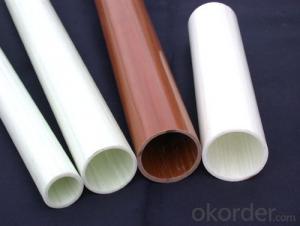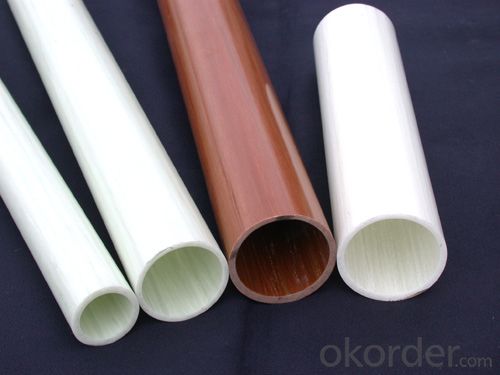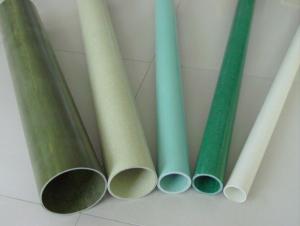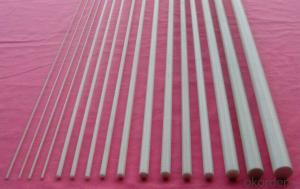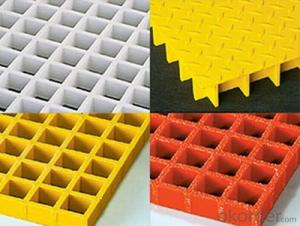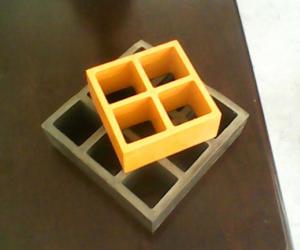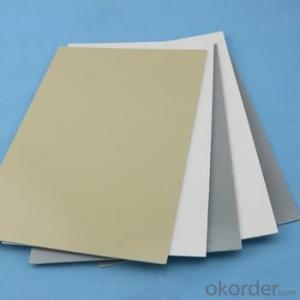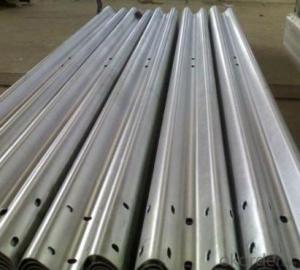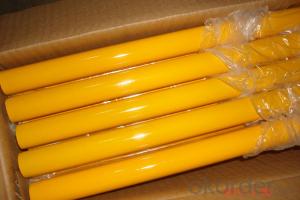FRP Pultrusion Profiles - Fiberglass Pultruded Broom Handle
- Loading Port:
- China Main Port
- Payment Terms:
- TT OR LC
- Min Order Qty:
- -
- Supply Capability:
- -
OKorder Service Pledge
OKorder Financial Service
You Might Also Like
Specifications of Fiberglass Pultruded Broom Handle:
1. diameter from 1mm to 50mm
2. any color available
3. any length
4. quickly deliver
Product Description of Fiberglass Pultruded Broom Handle:
1. diameter from 1mm to 50mm
2. any color available
3. any length
4. quickly delivery
Fiberglass rods, FRP rods |
Diameter: 1mm 2mm 3mm 4mm 5mm 6mm 7mm 8mm 9mm 9.5mm 10mm 11mm 12.7mm 14mm15mm 16mm 18mm 19mm 20mm to 50mm |
Color: red, black, white, yellow, blue, green, white, gray, any color |
Length: cut according customer requirement |
OEM: available |
High Strength, Corrosion resistance, Chemical resistance, Flexibility, Aging resistance |
- Q: How do FRP pultrusion profiles perform in extreme heat temperatures?
- FRP pultrusion profiles are renowned for their exceptional performance in extreme heat conditions. The profiles acquire remarkable heat resistance properties due to the distinct combination of materials utilized in the pultrusion process, such as fiberglass reinforcement and thermosetting resin matrix. One of the primary benefits of FRP pultrusion profiles lies in their capacity to uphold dimensional stability even when subjected to elevated temperatures. Unlike conventional materials like steel or aluminum, which may expand or deform under extreme heat, FRP profiles retain their shape and structural integrity. Consequently, they offer a high level of reliability in applications where temperature fluctuations are frequent or where exposure to intense heat is prevalent. Furthermore, FRP pultrusion profiles possess exceptional thermal insulation properties. They possess a low thermal conductivity, effectively impeding heat transfer. This characteristic proves advantageous in situations where heat control or isolation is necessary, preventing the profiles from becoming excessively hot. Moreover, FRP pultrusion profiles boast a high heat distortion temperature (HDT). HDT refers to the temperature at which a material begins to deform under a specific load. Typically, the HDT of FRP profiles surpasses that of other materials, enabling them to endure extreme heat without compromising their structural integrity. In conclusion, FRP pultrusion profiles are highly suitable for use in extreme heat conditions. Their ability to maintain dimensional stability, resist heat transfer, and withstand high temperatures renders them a dependable choice for diverse industries, including aerospace, automotive, and infrastructure.
- Q: Can FRP pultrusion profiles be customized according to specific requirements?
- Yes, FRP pultrusion profiles can be customized according to specific requirements. Pultrusion is a manufacturing process that allows for the creation of complex shapes and sizes, making it possible to tailor the FRP profiles to meet specific design and performance criteria. This customization can include modifications in dimensions, reinforcement types, resin systems, color, surface finish, and various other parameters to ensure they meet the desired specifications and needs of the application.
- Q: Are FRP pultrusion profiles resistant to impact?
- FRP pultrusion profiles exhibit a general resistance to impact. The amalgamation of robust fibers and the polymer matrix employed during manufacturing renders FRP profiles exceptionally enduring, enabling them to endure substantial impacts without fracturing or shattering. Furthermore, the pultrusion process guarantees the uniform dispersion of fibers within the profile, thereby bolstering its capacity to resist impact. Consequently, FRP pultrusion profiles are ideally suited for impact-prone applications, including construction, transportation, and infrastructure ventures.
- Q: What are the maintenance requirements for FRP pultrusion profiles?
- The maintenance requirements for FRP (Fiber Reinforced Polymer) pultrusion profiles are generally quite low. FRP pultrusion profiles are known for their durability and resistance to corrosion, making them a low-maintenance option for various applications. However, there are a few key maintenance practices that can help prolong the lifespan and ensure optimal performance of FRP pultrusion profiles. 1. Regular Cleaning: Periodic cleaning is important to remove any dirt, dust, or debris that may accumulate on the surface of the profiles. This can be done using a mild detergent solution and a soft brush or cloth. Avoid using abrasive cleaners or materials that may scratch the surface. 2. Inspection: Regular visual inspections should be carried out to identify any signs of damage or wear. Inspect the profiles for cracks, chips, delamination, or any other visible defects. If any issues are detected, they should be addressed promptly to prevent further damage. 3. UV Protection: FRP pultrusion profiles are generally resistant to UV radiation, but prolonged exposure to direct sunlight can eventually cause some degree of degradation. Applying a UV protective coating or using a UV-resistant paint can help minimize the effects of UV exposure and extend the lifespan of the profiles. 4. Lubrication: If the pultrusion profiles have moving parts or connections, such as hinges or joints, applying a suitable lubricant can help ensure smooth operation and prevent friction-related issues. It is important to use lubricants that are compatible with FRP materials to avoid any adverse chemical reactions. 5. Repair and Replacement: In case of any significant damage or wear, it may be necessary to repair or replace the affected sections of the FRP pultrusion profiles. This should be done by trained professionals who have experience working with FRP materials to ensure proper repair techniques and maintain structural integrity. Overall, while FRP pultrusion profiles require minimal maintenance, regular cleaning, inspection, and addressing any issues promptly are key to ensuring their longevity and optimal performance. Following these maintenance practices can help maximize the lifespan of FRP pultrusion profiles and maintain their structural integrity over time.
- Q: Are FRP pultrusion profiles resistant to sulfuric acid?
- FRP pultrusion profiles display a notable resistance to sulfuric acid and this corrosion resistance is a key advantage they hold over traditional materials like steel or concrete. Sulfuric acid, known for its highly corrosive nature, poses no threat to FRP pultrusion profiles due to the inherent properties of the composite materials used in their construction. The primary reason behind the corrosion resistance of FRP profiles lies in the resin matrix that encases the reinforcing fibers. The commonly utilized resins in pultrusion, namely polyester, vinyl ester, and epoxy, exhibit remarkable chemical resistance, including resistance to sulfuric acid. However, it is essential to acknowledge that the resistance of FRP pultrusion profiles to sulfuric acid can vary based on multiple factors. The concentration and temperature of the acid, as well as the specific resin formulation employed in the profile, can impact the overall resistance. In scenarios involving highly concentrated acid or elevated temperatures, it is advisable to consult the manufacturer or supplier to ensure that the specific FRP profile meets the necessary resistance requirements. On the whole, FRP pultrusion profiles offer a high level of resistance to sulfuric acid, making them apt for a wide range of applications in industries where this corrosive substance may be present, such as chemical processing, wastewater treatment, or mining.
- Q: Are FRP pultrusion profiles resistant to chemicals used in oil refineries?
- Yes, FRP (Fiber Reinforced Polymer) pultrusion profiles are highly resistant to chemicals used in oil refineries. The composition of FRP profiles includes a combination of high-strength fibers, such as fiberglass, carbon fibers, or aramid fibers, embedded in a polymer resin matrix. This unique construction provides excellent resistance to a wide range of chemicals, including those commonly found in oil refineries. The polymer resin matrix used in FRP profiles can be carefully selected to withstand harsh chemical environments. For instance, vinyl ester or epoxy resins are often used in the manufacturing of FRP profiles for oil refinery applications due to their superior chemical resistance properties. Moreover, FRP pultrusion profiles are inherently corrosion-resistant, unlike traditional materials like steel or concrete, which can deteriorate when exposed to aggressive chemicals found in oil refineries. This corrosion resistance ensures the long-term durability and reliability of FRP profiles in such environments. Additionally, FRP profiles offer several other advantages in oil refinery applications, including high strength-to-weight ratio, electrical insulation, non-magnetic properties, and ease of installation. These characteristics make FRP pultrusion profiles an ideal choice for various structural, piping, and equipment applications within oil refineries. However, it is essential to consider the specific chemicals and concentrations involved in a particular oil refinery application. While FRP profiles generally exhibit excellent resistance to a wide range of chemicals, there might be certain highly concentrated or specialized chemicals that could potentially affect their performance. In such cases, it is advisable to consult with FRP manufacturers or experts who can provide tailored solutions to meet the specific chemical resistance requirements of the oil refinery.
- Q: Are FRP pultrusion profiles resistant to moisture or humidity?
- Yes, FRP (Fiber Reinforced Polymer) pultrusion profiles are highly resistant to moisture and humidity. The pultrusion process involves impregnating continuous fibers with a polymer resin, resulting in a strong and durable composite material. This composite is inherently moisture-resistant and does not absorb water like traditional materials such as wood or metal. Additionally, FRP pultrusion profiles have a low coefficient of thermal expansion, meaning they are less likely to expand or contract under varying levels of humidity. This resistance to moisture and humidity makes FRP pultrusion profiles suitable for a wide range of applications, including outdoor structures, marine environments, and other moisture-prone areas.
- Q: Can FRP pultrusion profiles be used in the transportation and logistics industry?
- FRP pultrusion profiles have the capability to be utilized in the transportation and logistics sector. They possess a multitude of advantages that render them suitable for diverse applications within this industry. To begin with, FRP pultrusion profiles are both lightweight and exceptionally robust, ensuring durability. This characteristic makes them highly suitable for implementation in transportation vehicles such as trucks, trailers, and containers, where weight reduction is crucial for enhancing fuel efficiency and minimizing emissions. Despite their lightweight nature, FRP pultrusion profiles are capable of enduring heavy loads and harsh environmental conditions, thereby guaranteeing their reliability and longevity. Furthermore, FRP pultrusion profiles exhibit remarkable resistance to corrosion. Unlike conventional materials like steel or aluminum, FRP does not succumb to rust or corrosion when subjected to moisture or chemicals. This renders FRP profiles apt for applications in transportation and logistics that involve exposure to corrosive substances like saltwater, chemicals, or acidic environments. By incorporating FRP pultrusion profiles, companies can curtail maintenance expenses associated with corrosion and prolong the lifespan of their equipment. In addition, FRP pultrusion profiles offer flexible design options. They can be manufactured in a myriad of shapes, sizes, and configurations to cater to the specific requirements of transportation and logistics applications. Whether it entails structural components, platforms, flooring, or supports, FRP profiles can be tailored to accommodate diverse needs, thereby ensuring optimal performance and functionality. Moreover, FRP pultrusion profiles possess exceptional electrical and thermal insulation properties. This renders them suitable for applications in which electrical conductivity needs to be minimized or thermal insulation is necessary. Within the transportation and logistics industry, this feature can be advantageous for applications like insulation for refrigerated containers or electrical insulation for specialized vehicles. In conclusion, FRP pultrusion profiles are highly suitable for implementation in the transportation and logistics sector. Their lightweight, robust, corrosion-resistant, and customizable nature, combined with their electrical and thermal insulation properties, render them a dependable choice for diverse applications within this field.
- Q: Can FRP pultrusion profiles be used in cooling towers?
- Cooling towers can indeed utilize FRP (Fiber Reinforced Polymer) pultrusion profiles. These profiles possess several advantages that make them suitable for such applications. To begin with, the corrosion resistance of FRP pultrusion profiles is exceptional, a crucial attribute in a cooling tower setting where exposure to water and chemicals is commonplace. Unlike conventional materials like steel, FRP pultrusion profiles do not rust or corrode, ensuring a longer service life and reduced maintenance expenses. Secondly, FRP pultrusion profiles exhibit a high strength-to-weight ratio, rendering them lightweight yet sufficiently robust to meet the structural demands of cooling towers. This facilitates easier installation and transportation, ultimately reducing the overall project costs. Thirdly, FRP pultrusion profiles boast excellent thermal insulation properties. As cooling towers involve the transfer of heat from water to the surrounding air, the thermal insulation provided by these profiles enhances the efficiency of the cooling process. Lastly, FRP pultrusion profiles are highly customizable and can be tailored to meet the specific requirements of cooling tower applications. They can be engineered to possess various shapes, sizes, and dimensions, ensuring a precise fit for the cooling tower design. Overall, FRP pultrusion profiles represent a dependable and cost-effective choice for cooling tower applications. Their corrosion resistance, high strength-to-weight ratio, thermal insulation capabilities, and customization options make them an excellent option.
- Q: Are pultruded FRP sections strong? What are its main areas of application?
- More fields. Advantage is obvious, if the corrosion resistance, insulation resistance, quality is lighter than steel; strength and steel strength comparable;
Send your message to us
FRP Pultrusion Profiles - Fiberglass Pultruded Broom Handle
- Loading Port:
- China Main Port
- Payment Terms:
- TT OR LC
- Min Order Qty:
- -
- Supply Capability:
- -
OKorder Service Pledge
OKorder Financial Service
Similar products
Hot products
Hot Searches
Related keywords
